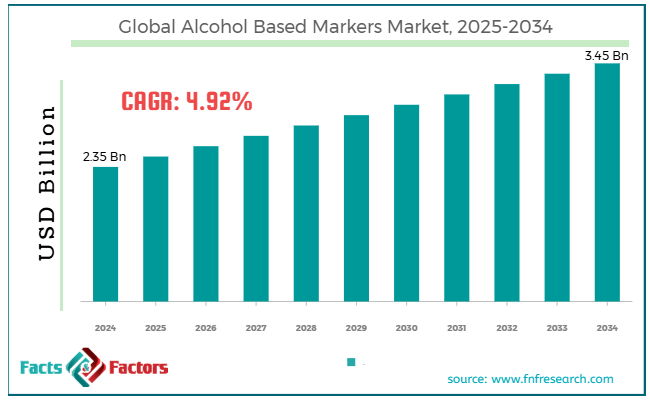Search Market Research Report
Alcohol Based Markers Market Size, Share Global Analysis Report, 2025 – 2034

Alcohol Based Markers Market Size, Share, Growth Analysis Report By Product Type (Single Tipped and Double Tipped), By Distribution Channel (Online Retail, Offline Retail, Supermarkets, and Specialty Stores), By End User (Art & Craft, Textile & Fabric, Packaging and Labeling, and Education), And By Region - Global Industry Insights, Overview, Comprehensive Analysis, Trends, Statistical Research, Market Intelligence, Historical Data and Forecast 2025 – 2034
Industry Insights
[219+ Pages Report] According to Facts & Factors, the global alcohol based markers market size was worth around USD 2.35 billion in 2024 and is predicted to grow to around USD 3.45 billion by 2034, with a compound annual growth rate (CAGR) of roughly 4.92% between 2025 and 2034.

 Market Overview
Market Overview
Alcohol based markers are the common stationery items known for their smooth application, vibrant colors, and fast-drying ink. The ink contains alcohol as a solvent, allowing the ink to blend perfectly and layer without ripping the paper. They are highly preferred by designers, illustrators, and comic artists for their professional finish and versatility. The worldwide alcohol based markers market is expected to progress noticeably over the estimated period, backed by the growing prominence of DIY and the increasing number of hobbyists, rise in design courses, high-performing properties, and e-commerce growth.
Platforms like Instagram, YouTube, and Pinterest have encouraged individuals to engage more in journaling and DIY activities, where alcohol based markers are widely used. Rising enrollment in fashion, design, product design courses, and architecture is surging the demand for expert-quality markers in educational institutes. Alcohol markers offer dual tips, seamless blending, refillability, and vibrant color variations, increasing their appeal among professionals. Moreover, with the growth of e-commerce, online sales have increased the affordability and accessibility of these markers.
Nonetheless, the global market is limited by health and ecological concerns, compatibility with paper, and easy access to low-quality substitutes. Alcohol based markers do not contain VOCs, which raises concerns regarding long-term health effects and indoor air quality. Their inks usually spoil the regular paper and demand users to work on premium and costly sheets. Also, the easy availability of water or gel-based markers in the market negatively impacts industry penetration.
Yet, the alcohol based markers industry is opportune to refillable marker innovations and EdTech learning platforms. Developing refillable, biodegradable, and low-VOC substitutes may offer opportunities and attract environment-conscious users. Moreover, associating with online learning platforms or integrating alcohol markers in STEAM education will spur the sales of these markers.
 Key Insights:
Key Insights:
- As per the analysis shared by our research analyst, the global alcohol based markers market is estimated to grow annually at a CAGR of around 4.92% over the forecast period (2025-2034)
- In terms of revenue, the global alcohol based markers market size was valued at around USD 2.35 billion in 2024 and is projected to reach USD 3.45 billion by 2034.
- The alcohol based markers market is projected to grow significantly owing to the rise in art education programs, mounting interest in crafting hobbies and DIY culture, and increasing consumer spending.
- Based on product type, the single tipped segment is expected to lead the market, while the double tipped segment is expected to grow considerably.
- Based on the distribution channel, the offline segment is the dominating segment among others, while the online segment is projected to witness sizeable revenue over the forecast period.
- Based on end user, the art & craft segment is expected to lead the market.
- Based on region, Asia Pacific is projected to dominate the global market during the estimated period, followed by North America.
 Growth Drivers
Growth Drivers
- The boom in creative hobbies and DIY culture fuel the market growth
Rise in crafting communities and the emergence of different types of DIY projects are surging the demand for alcohol based markers, thus the alcohol based markers market growth. Crafting, home improvement culture, and DIY have developed significantly in recent years.
Individuals are creating art comfortably at home, particularly with the rise of YouTube, Pinterest, and Instagram-like platforms, where users post their DIY creativity. This substantially surged the demand for quality and premium markers.
Moreover, alcohol based markers are now preferred for bullet journaling, home décor, scrapbooking, custom artwork, and adult coloring books. The versatility of these markers in blending and precision increases their choice for these activities.
- Customization and innovation in product features to spur market growth
A prominent innovation in the global market is the emergence of dual-tip markers, which offer fine tips and brush tips for different uses. This enables artists to use different tips for diverse cases and strokes, increasing their suitability for arty styles.
Moreover, markers with reusable or refillable ink are gaining traction. These products reduce waste and make them highly sustainable. A few brands offer refills that extend the durability of these markers, attracting eco-conscious consumers and professionals.
Furthermore, there is a mounting demand for markers with ergonomic design. These markers majorly decrease hand fatigue during long drawing sessions, which increases comfortability for prolonged periods.
Companies like Prismacolor and Copic have invested in such improvements, introducing markers with refillable inks, dual tips, and special colors that satisfy the demands of end users.
 Restraints
Restraints
- Shifting consumer choices negatively impacts market progress
Nonetheless, the rising shift towards digital art tools and demand for non-toxic markers restrain the global industry growth. With the increasing prominence of graphic design software and digital art, more artists are choosing digital tools over conventional stationery products. Digital art tools offer multiple benefits, such as undo options, endless customizations, and the ability to work on creativity irrespective of location.
In addition, users, especially schools and parents, are highly focused on eco-friendly markers that avoid emitting hazardous fumes. This shift is regarded as safe and environmentally friendly for children. In 2023, key retailers reported a 15% surge in sales of water-based markers than alcohol based markers, underscoring an inclination towards hazardous and digital alternates.
 Opportunities
Opportunities
- The growth of e-commerce platforms positively impacts market growth
The worldwide expansion of online shopping has developed as a transformative propeller for alcohol based markers market. Online portals offer an extensive and convenient platform for users to compare, explore, and buy a broad range of alcohol based markers. This global accessibility, irrespective of geographical constraints, enables users to choose their desired products from various brands.
E-commerce simplifies the launch of specialty and niche markers, satisfying specific consumer requirements. This simplicity of online purchase along with effective shipping and delivery solutions majorly impact the industry growth.
 Challenges
Challenges
- Regulatory compliance issues and supply chain vulnerabilities hamper the growth of market
Companies are witnessing regulatory pressures to comply with safety and environmental standards. The alcohol markers market is also heavily dependent on the global supply of resources and basic materials, which makes it vulnerable to disturbances. The EU’s REACH protocol limits harmful substances, compelling manufacturers to replace risky chemicals. Nonetheless, substitutes like bio-based polymers are costlier and need reengineering manufacturing lines.
 Report Scope
Report Scope
Report Attribute |
Details |
Market Size in 2024 |
USD 2.35 Billion |
Projected Market Size in 2034 |
USD 3.45 Billion |
CAGR Growth Rate |
4.92% CAGR |
Base Year |
2024 |
Forecast Years |
2025-2034 |
Key Market Players |
Prismacolor, Winsor & Newton, Chameleon Art Products, Blick Art Materials, Arteza, Tombow, ShinHan Art (Touch Markers), Chartpak (AD Markers), Spectrum Noir, Zig Kurecolor (by Kuretake), Staedtler, Crayola, Faber-Castell, Derwent, Promarker (by Winsor & Newton), and others. |
Key Segment |
By Product Type, By Distribution Channel, By End User, and Region |
Major Regions Covered |
North America, Europe, Asia Pacific, Latin America, and the Middle East &, Africa |
Purchase Options |
Request customized purchase options to meet your research needs. Explore purchase options |
 Segmentation Analysis
Segmentation Analysis
The global alcohol based markers market is segmented based on product type, distribution channel, end user, and region.
Based on product type, the global alcohol based markers industry is divided into single tipped and double tipped. The single-tipped segment held a notable share of the market owing to their affordability and versatility. They are commonly used for artistic uses like sketching, illustration, and coloring. Artists praise the simplicity of alcohol-based single-tipped markers that offer broad and fine strokes.
Moreover, single tipped markers are usually cheaper than dual-tipped markers, increasing their accessibility to a broader consumer base. Their affordability, ease of use, and flexibility have increased their dominance in the global market.
Though the single-tipped segment presently leads the market because of its cost-effectiveness and broader use, the dual-tipped segment is gaining traction among enthusiasts and professionals looking for better versatility in their creative activities.
Based on distribution channel, the global alcohol based markers industry is segmented as online retail, offline retail, supermarkets, and specialty stores. The offline retail segment registered maximum market share in the previous years and is leading notably. These physical stores offer users the opportunity to avail marker colors, quality, and features firsthand, mainly attracting professionals and artists who seek a physical shopping experience. The well-established presence of these offline physical stores plays a key role in the industry's dominance.
Though the offline retail dominates the industry due to hands-on shopping experience and leading presence, online retail channels are speedily gaining attention, fueled by the accessibility and convenience they offer to a broad user base.
Based on end user, the global market is segmented as art & craft, textile & fabric, packaging and labeling, and education. The art & craft segment captured a significant market share in 2024 and is anticipated to lead considerably due to the high popularity of adult coloring books, DIY projects, and hobbyist activities.
Alcohol based markets are highly preferred for their smooth application, vibrant colors, and super blending abilities, which make them suitable for diverse artistic activities. The segment comprises a broad range of users, including professional and casual artists, who contribute to its leading industry share.
 Regional Analysis
Regional Analysis
- Asia Pacific to witness significant growth over the forecast period
Asia Pacific held a dominating share of the alcohol based markers in 2024 and is projected to lead considerably in the future, backed by increasing disposable income and economic growth, rising emphasis on arts, growth of DIY culture, e-commerce growth, and product improvements.
Speedy economic development in nations like India, China, Japan, and South Korea has increased the disposable income of users to spend on quality stationery materials like alcohol based markers. Nations like South Korea and Japan have strong creative and educational cultures, nurturing rising demand for art supplies and impacting regional growth. The rising prominence of DIY projects has fueled interest in craft and art activities, thus driving the demand for these markers.
Moreover, the rise of online portals has increased the accessibility of these markers, streamlining easy comparison and purchase. Furthermore, companies are launching improved features like refillable ink cartridges, dual tips, and environment-friendly formulations, satisfying the changing consumer needs and widening the industry attraction.
North America ranks as the second-leading market in the global alcohol based markers industry due to well-developed art and design sectors, progressing crafting and DIY culture, improved distribution channels, creative programs, and sustainability.
North America brags about its rich culture in arts & design, with leading professional artists, illustrators, and designers fueling the demand for the best quality art items. The rising interest in DIY projects and adult coloring books has majorly fueled the use of these markers among enthusiasts and hobbyists. Offline and online retailers are well-established, offering users easy access to different markers.
Also, the surged presence of famous creative programs and art schools in North America contributes to a steady demand for quality art items. In addition, manufacturers of alcohol based markers are emphasizing innovations like refillable ink cartridges, dual-tip design, and eco-friendly makings to satisfy the changing consumer needs.
 Competitive Analysis
Competitive Analysis
The global alcohol based markers market is led by players like:
- Prismacolor
- Winsor & Newton
- Chameleon Art Products
- Blick Art Materials
- Arteza
- Tombow
- ShinHan Art (Touch Markers)
- Chartpak (AD Markers)
- Spectrum Noir
- Zig Kurecolor (by Kuretake)
- Staedtler
- Crayola
- Faber-Castell
- Derwent
- Promarker (by Winsor & Newton)
 Key Market Trends
Key Market Trends
- Educational integration:
Educational institutions are actively integrating alcohol based markers in their syllabuses, promoting artistic and creative expression among their students. This trend is backed by the rising private and governmental funding for arts education, strengthening its significance in personal development.
- Social media impact:
Platforms like Pinterest and Instagram are augmenting the trend of using alcohol based markers by displaying art projects that use these attractive markers. This encourages others to buy the same markers and imitate the artistic creations. This visibility fuels the demand for these markers, thus the market growth.
The global alcohol based markers market is segmented as follows:
 By Product Type Segment Analysis
By Product Type Segment Analysis
- Single Tipped
- Double Tipped
 By Distribution Channel Segment Analysis
By Distribution Channel Segment Analysis
- Online Retail
- Offline Retail
- Supermarkets
- Specialty Stores
 By End User Segment Analysis
By End User Segment Analysis
- Art & Craft
- Textile & Fabric
- Packaging and Labeling
- Education
 By Regional Segment Analysis
By Regional Segment Analysis
- North America
- The U.S.
- Canada
- Mexico
- Europe
- France
- The UK
- Spain
- Germany
- Italy
- Rest of Europe
- Asia Pacific
- China
- Japan
- India
- Australia
- Southeast Asia
- Rest of Asia Pacific
- The Middle East & Africa
- Saudi Arabia
- UAE
- Egypt
- Kuwait
- South Africa
- Rest of the Middle East & Africa
- Latin America
- Brazil
- Argentina
- Rest of Latin America
Industry Major Market Players
- Prismacolor
- Winsor & Newton
- Chameleon Art Products
- Blick Art Materials
- Arteza
- Tombow
- ShinHan Art (Touch Markers)
- Chartpak (AD Markers)
- Spectrum Noir
- Zig Kurecolor (by Kuretake)
- Staedtler
- Crayola
- Faber-Castell
- Derwent
- Promarker (by Winsor & Newton)
Frequently Asked Questions

Copyright © 2024 - 2025, All Rights Reserved, Facts and Factors


